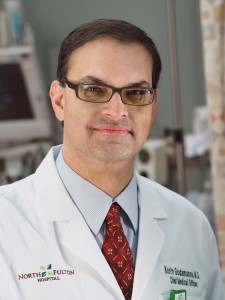by Dr. Karim Godamunne MD, MBA, SFHM
Every day we admit patients to the hospital and on day one we order a diet or maybe we don’t and we wait, and wait and occasionally wait some more. Or maybe we just don’t order enough (nutrition that is). Evidence from the Journal of Parental and Enteral Nutrition suggests that in 2010 only 3.2% of hospitalized patients got a diagnosis of malnutrition – remarkably this is over 2 times better than in 2000 when less than 1.5% of patients were coded with a diagnosis of malnutrition. Recent literature has also reported that between 21% and 54% of hospitalized patients have malnutrition and thus there appears to be a significant “malnutrition gap.” With 1 in 3 hospitalized patients demonstrating malnutrition characteristics but only 1 in 30 have a documented diagnosis of malnutrition – a 10 fold “malnutrition gap” exists.
There are several evidence based consequences of ongoing malnutrition in hospitalized patients. Including: the almost 50% of patients that fall in hospitals meet malnutrition criteria, pressure ulcers occurring 2 times more frequently in malnourished patients, and an increased risk of surgical site infections and a higher rate of readmissions.
How do we recognize malnutrition? A clinically useful way (but not the only way) is to assess the patient for starvation and/or inflammation. Starvation equals malnutrition. Is there inflammation is it acute or chronic? Sustained chronic inflammation and/or significant acute inflammation support a diagnosis of malnutrition especially in patients that fail a standardized Malnutrition Screening Tool (MST). Examples of ongoing chronic inflammation include cancer, cirrhosis and auto-immune disorders. Examples of significant acute inflammation include sepsis, burns and trauma. Many patients we see in the hospital will have both chronic and acute inflammation making them that much more likely to have malnutrition. Particularly susceptible are elderly nursing home patients who may have inflammation superimposed on a state of chronic malnutrition.
What can we as hospitalists do?
First, we need to remember to use our clinical skills to assess the patient nutritionally, looking for signs of starvation, ongoing chronic and/or acute inflammation. This includes taking a good history and conducting a thorough physical supported by relevant labs, and other functional and subjective parameters.
Second, we need to intervene promptly with the malnourished patient – don’t wait 72 hours to start that TPN or enteral feed, start now if so indicated!
Third, we need to reach out to our healthcare colleagues (nurses, nutritionists, etc.) to work collaboratively to improve processes, developed systems of care, promote the use of standardized screening tools, like MST, and utilize educational opportunities to promote nutrition. There are excellent resources available online to help from both The Alliance to Advance Patient Nutrition and from A.S.P.E.N.
Finally, we need to document malnutrition as a diagnosis, i.e. put pen to paper or document in the electronic medical record and understand the characteristics that have been defined in your institution to determine malnutrition.
Hospitalists are well positioned to help resolve the “malnutrition gap.” You can help!
*Please note: SHM is a partner in the Alliance to Advance Patient Nutrition, which is made possible with support from Abbott Nutrition.*
 Dr. Karim Godamunne is the Chief Medical Officer for North Fulton Hospital, Roswell, GA. Previously, he was the Vice President of Clinical Systems Integration with Eagle Hospital Physicians as well as the Medical Director of the Advanced Primary Stroke Center and Hospitalist Program at South Fulton Medical Center, East Point, GA. Dr. Godamunne is an Assistant Professor of Family Medicine at the Morehouse School of Medicine and was Co-Director of the Morehouse Family Medicine inpatient teaching program from 2010 through 2012. Dr. Godamunne is Board Certified in Internal Medicine, Focus Practice Certified in Hospital Medicine and is a Senior Fellow in Hospital Medicine (SFHM). He obtained his MBA from Stanford University and trained in Internal Medicine at Columbia University Medical Center.
Dr. Karim Godamunne is the Chief Medical Officer for North Fulton Hospital, Roswell, GA. Previously, he was the Vice President of Clinical Systems Integration with Eagle Hospital Physicians as well as the Medical Director of the Advanced Primary Stroke Center and Hospitalist Program at South Fulton Medical Center, East Point, GA. Dr. Godamunne is an Assistant Professor of Family Medicine at the Morehouse School of Medicine and was Co-Director of the Morehouse Family Medicine inpatient teaching program from 2010 through 2012. Dr. Godamunne is Board Certified in Internal Medicine, Focus Practice Certified in Hospital Medicine and is a Senior Fellow in Hospital Medicine (SFHM). He obtained his MBA from Stanford University and trained in Internal Medicine at Columbia University Medical Center.


Leave A Comment